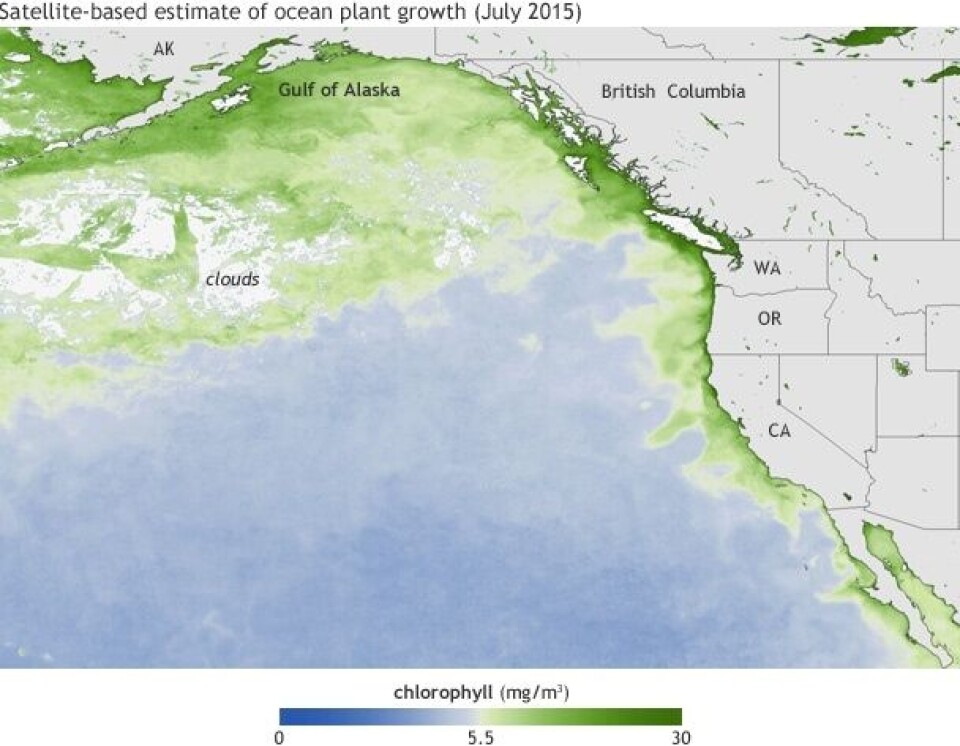
Record-setting bloom of toxic algae in North Pacific
The bloom of poisonous domoic acid-producing microscopic algae called Pseudo-nitzschia is reportedly found in a ribbon up to 64 kilometres wide and in places it goes down to a depth close to 200 metres. It has caused the closure of certain fisheries along the west coast of North America, including one on west coast of Vancouver Island but there are no reports of losses among the region’s fish farms, some of which have been affected by algae blooms in previous years.
In a statement issued today, the US National Oceanic and Atmospheric Administration (NOAA) provided some background information about the phenomenon:
A record-breaking algal bloom continues to expand across the North Pacific reaching as far north as the Aleutian Islands and as far south as southern California. Coinciding with well above average sea surface temperatures across the North Pacific and West Coast of North America, the bloom is laced with some toxic species that have had far-reaching consequences for sea life and regional and local economies.
Algal blooms in the ocean are made up of microscopic marine plants known as phytoplankton. Not all phytoplankton are dangerous, but certain species produce dangerous neurotoxins. Shellfish and some fish eat the toxic algae as part of their normal diet, which can then expose their predators—including marine mammals and humans—to the neurotoxins in amounts that can cause illness and, in extreme cases, death.
While algal blooms do occur with regularity across the Pacific Ocean, the size and duration of this year’s event, which began in May, has been particularly noteworthy. Scientists can track the spread and amount of large algal blooms with satellites by looking at chlorophyll concentrations at the ocean surface. As the map shows, high concentrations of surface chlorophyll were present in coastal areas up and down the West Coast and a across a wide swath of the Gulf of Alaska. These high chlorophyll concentrations include both harmful and beneficial phytoplankton that produce over 50% of the world’s oxygen.
With its large size, the bloom has had a large impact on marine life and fisheries up and down the West Coast. According to Alaska Dispatch News in Anchorage, at least 9 Fin whales were found dead near Kodiak Island, AK, in June, potentially related to the algal bloom, although definitive proof that the deaths were caused by toxic algae will be difficult to obtain. In July, the Aleutian Pribilof Islands Association received reports of dead and dying whales, gulls, and forage fish in Alaska’s Aleutian Islands, with samples being solicited to test for algal toxins.
Over the past several months, extremely high levels of an algal toxin called domoic acid, which is produced by a group of phytoplankton called Pseudo-nitzschia, have led to closures of recreational razor clam harvests in Oregon and Washington, as well as closing of large portions of the Washington state Dungeness crab fishery and some of the sardine and anchovy fisheries in California. A press release from the Monterey Bay Aquarium Research Institute stated that “During a normal Pseudo-nitzschia bloom, domoic-acid concentrations of 1,000 nanograms per liter would be considered high. However, by mid May concentrations in Monterey Bay reached 10 to 30 times this level.”






















































